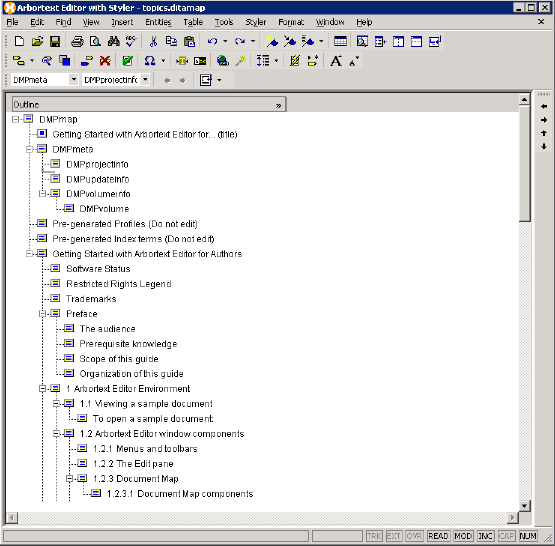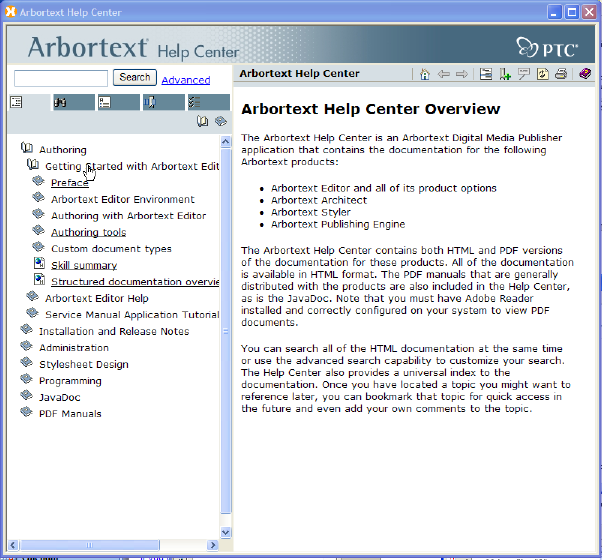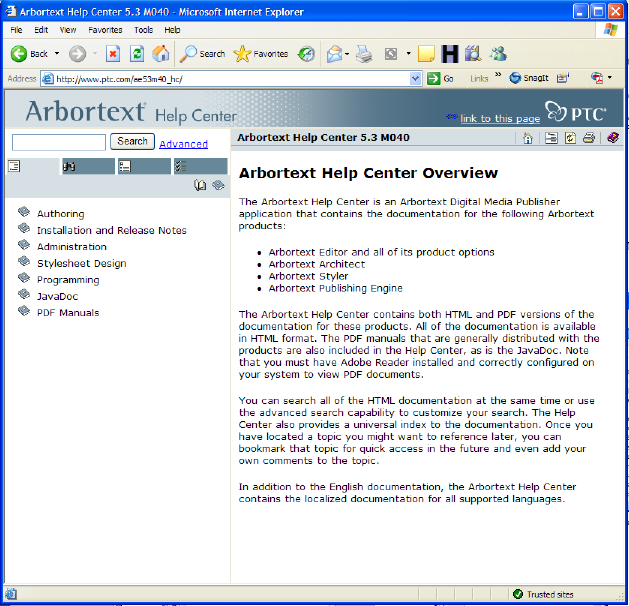Arbortext® Digital Media Publisher (DMP) has been available as a standalone product for some time, but in the upcoming release DMP provides a DITA-based integration with Arbortext Editor that enables you to create a Help system or other online information system directly from a DITA map.
Overview
DMP enables you to take a set of documents and compose them to various types of output. The documents can be of several different types including DITA and other types of XML documents, HTML, PDF, Microsoft Word®, Microsoft PowerPoint®, Microsoft Excel®, Javadoc, or just text documents. Once you have compiled your set of content, you can use DMP to compose that content to the following types of output:
DMP is a browser-based application and uses either an embedded browser (based on Internet Explorer) or the native browser installed on a system to serve up the content. DMP is a cross-platform application and runs on Windows®, Linux®, and some types of UNIX®. DMP also supports multiple languages in the same image.
PTC® offers more information on DMP at the PTC web site.
Setup and configuration
DMP can be purchased from PTC, either as a standalone product or bundled with Arbortext Publishing Engine. DMP comes with its own installation program. To create a DMP image directly from a DITA map also requires Arbortext Editor.
You can configure a DMP image in the following ways:
DMP as a standalone product
DMP has some Java™ property files that you use to set up the application properties and a content configuration XML file that you use to identify both the content sets to go in the application and the structure of the table of contents. You can also apply metadata to the table of contents to filter the content displayed in the image based on any criteria you define. Once you have completed setting up your configuration files and content sets, you can run a DMP build to create the DMP image.
DMP in conjunction with Arbortext Editor
You can use Arbortext Editor to edit a specialized DITA map called a “DMP Map” to construct the table of contents and reference the associated content. In this case, you can create a DMP image directly from the map. A DMP Map supports all of the configuration options available in the standalone DMP configuration.
Following is an example of a DMP Map:
Authoring
Authors will need to learn about the specialized elements and attributes in a DMP Map to use the map. However, for authoring regular DITA topics and maps, nothing special is required.
Integration
DMP provides both a Java API and an XML RPC API. The same features are available in both of these APIs. The API provides several capabilities, including displaying an individual topic based on an ID and searching through HTML metadata for strings or IDs to find the appropriate topic to display. Application developers can use the DMP API to integrate a DMP image with their software for use as online Help.
All PTC documentation groups will be using DMP images for their products' online Help.
Output
A DMP image is highly customizable. All of the images/icons, colors, text, and features of a DMP image can be modified or removed during configuration. The default image contains the following features:
Table of Contents tab — Provides a table of contents for the content in the image.
Search tab — Contains search results, arranged either by relevance or position in the table of contents.
Index Terms tab — Contains a universal index for the content in the image.
Bookmark tab — Contains personal bookmarks and comments for individual topics.
Configuration tab — Enables the Help Center image to be customized in various ways (for example, switching to a different language or filtering the content based on various metadata criteria).
Search field — Enables you to enter search terms with full Boolean, wildcard, and other standard search support.
Advanced search — Enables you to filter search results based on various criteria.
Toolbar — Provides access to various DMP features.
View frame — Displays the current topic.
Following is a DMP image delivered in the embedded browser for use as online Help or a standalone knowledge base:
Following is the same image delivered as a web application:
The main difference between the two images is that the bookmark and commenting feature in the standalone image is replaced by the web browser's favorites or bookmarks capability. For either case, displaying documents other than HTML leverages browser plug-ins. For example, PDF documents are displayed in the View frame in the Adobe® Reader plug-in.
Summary
Arbortext Digital Media Publisher enables you to go directly from a DITA map to a composed image. It is a highly flexible product that can be customized as needed. The DMP API enables integration with other products for use as online Help or a knowledge base.
Chris Goolsby
PTC Corporation / Arbortext
OASIS DITA Help Subcommittee


